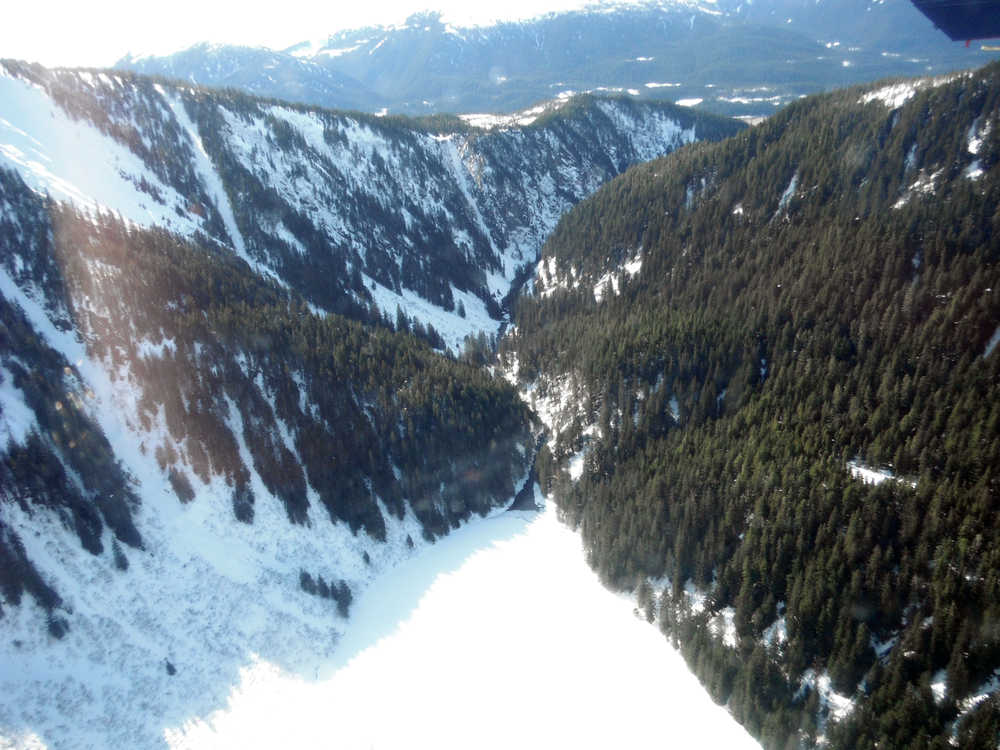In 1952, then U.S. Secretary of the Interior Oscar L. Chapman told Congress that Juneau’s Sweetheart Lake was “an important source of water for potential production of hydroelectric energy.”
More than six decades later, a company is finally about to tap into that potential.
At its Tuesday night meeting, the Juneau Planning Commission unanimously approved a conditional use permit green lighting Juneau Hydropower’s Sweetheart Lake Hydroelectric Project. This city permit is a crucial piece of the permitting puzzle that the minds behind Juneau Hydropower have been working on for the past six years. But they’re not finished yet.
In order to begin construction of the hydroelectric facility — which will comprise a 280-foot wide concrete damn and three 7.1-megawatt turbines among other things — Juneau Hydropower still needs a license from the Federal Energy Regulatory Commission.
Duff Mitchell, the company’s managing director, said that license “is imminent.”
The company is well ahead of the 10-year average it usually takes projects of a similar scope to obtain a FERC license, and Mitchell said that is because “we submitted our homework early — at our own expense.”
The company has nearly everything but the signatures it needs on 25 environmental preliminary plans, including a Bear Safety Plan, it had to submit to the U.S. Forest Service. Typically, companies don’t start working on these plans until after they are granted a FERC license, Mitchell said.
Once Juneau Hydropower has the notice to proceed, it will begin construction, which Mitchell hopes will happen later this year.
The Planning Commission approved the conditional use permit with little discussion. According to Teri Camery, a senior planner with the city’s Community Development Department, the city hasn’t received any public opposition regarding the Sweetheart Lake project.
Two people testified in support of Juneau Hydropower’s plan Tuesday night. Corey Baxter, a representative of the International Union of Operating Engineers Local 302, and Dick Hand, owner of Alaska Seafood Company, both said that the project would create jobs and support economic development.
The conditional use permit shows that the Sweetheart Lake project conforms to the city’s Comprehensive Plan and its Climate action plan, both of which Mitchell said the company “hit in spades.”
Juneau Hydropower plans to use its 19.8 megawatt facility to power the Kensington Mine. Sweetheart Lake is located near Port Snettisham, about 37 miles southeast of Downtown Juneau.
Quarry expansion
The Planning Commission also approved a conditional use permit for the expansion of the city-owned Stabler Point Rock Quarry on Tuesday.
Last year was the busiest year on record for the rock quarry, which is located near the Ferry Terminal in Auke Bay. Private developers and the city mined more than 470,000 tons of rock from the quarry, accounting for nearly one quarter of all the rock mined since the city began operating the quarry 15 years ago.
With it’s new conditional use permit, the quarry will be able expand up the hill on which it sits, providing access to an additional 2.3 million tons of rock. According to the city’s Lands and Resources Manager Greg Chaney, this is necessary for future development.
“Nobody expected the demand for material to be so high,” he told the Planning Commission on Tuesday. “Over time, this has become the preferred source of hard rock in town, and once you get a quarry in place, it’s a lot easier to keep moving forward with it than it is to find a new quarry site.”
Some of the biggest draws on the quarry in the last couple years have been the city’s Statter Harbor improvements in Auke Bay and the Downtown Seawalk Project, which includes a manmade island consisting almost entirely of Stabler Point rock.
The conditional use permit will also allow the city to increase the size of the blasts it uses to free rock in the quarry. One Auke Bay resident who spoke during the public comment period of the meeting expressed concern about the larger blasts, worrying that they might cause vibrations that would damage her home.
Chaney and Quarry Operator Alec Venechuk both assured her that this wouldn’t be the case. On the contrary, using larger blasts will allow quarry operators to use explosives less, they said. This is because they blast until they get the amount of rock they need. It will take fewer blasts to get the same quantity of rock if those blasts are larger.
“The larger the blasts we can do the less frequent they’ll be,” Venechuk said.
The conditional use permit didn’t change the quarry’s hours of operation — 8 a.m. to 4:30 p.m. Monday through Friday — nor did it change the hours during which blasting is permitted. Blasting can only take place from 10 a.m. to noon and then from 1 p.m. to 3 p.m. Monday through Friday.
• Contact reporter Sam DeGrave at 523-2279 or sam.degrave@juneauempire.com.

